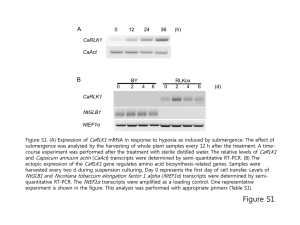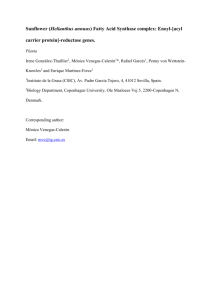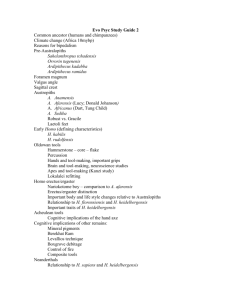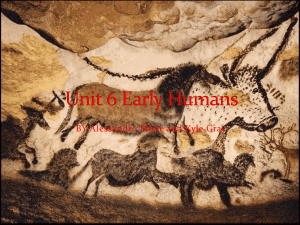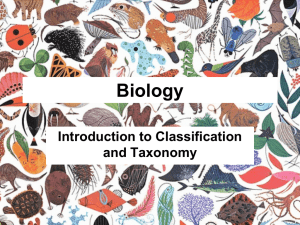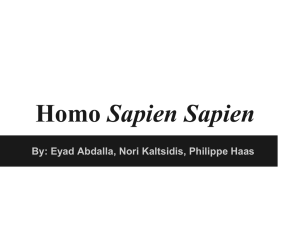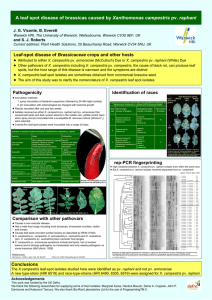evol_ecol28-supp
advertisement
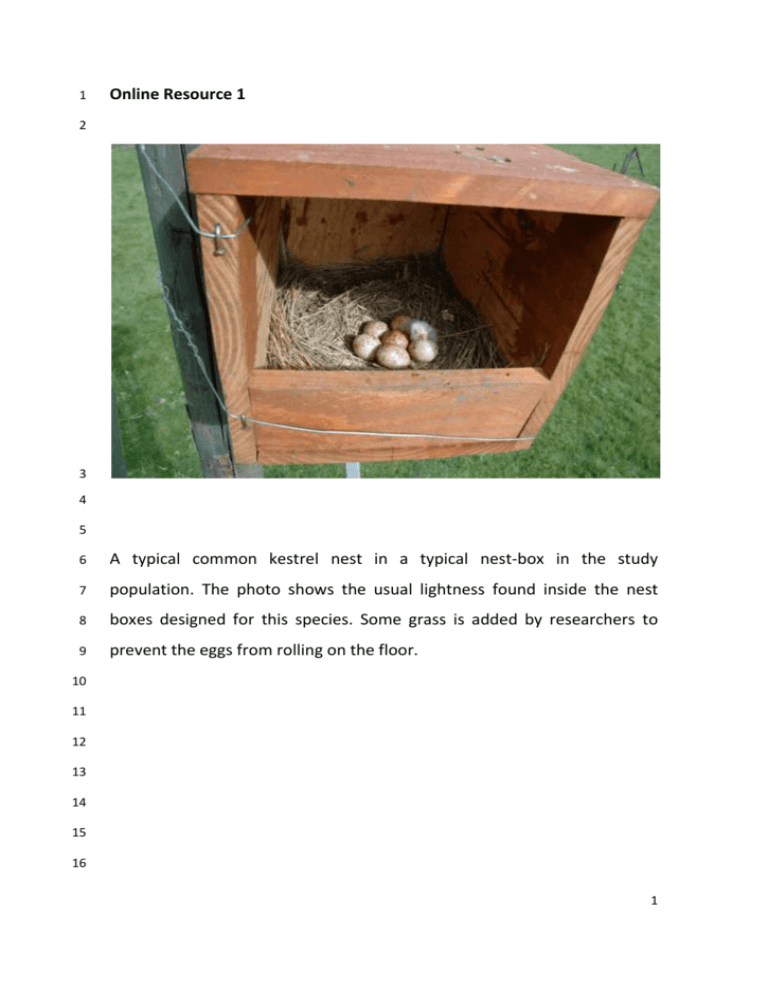
1 Online Resource 1 2 3 4 5 6 A typical common kestrel nest in a typical nest-box in the study 7 population. The photo shows the usual lightness found inside the nest 8 boxes designed for this species. Some grass is added by researchers to 9 prevent the eggs from rolling on the floor. 10 11 12 13 14 15 16 1 17 Online Resource 2 18 19 EGGSHELL PIGMENT IDENTIFICATION AND MEASUREMENTS 20 Eggshells and half cotton pieces were extracted (and esterified) by 15 ml absolute 21 methanol (LiChrosolv, gradient grade for chromatography, Merck, Darmstadt, 22 Germany) containing 5% concentrated sulphuric acid at room temperature in the dark 23 under N2 for 24 hours. Extracts were decanted and 10 ml chloroform (Merck; 24 chloroform GR, ISO) and 10 ml distilled water were added, then shaken. The lower 25 (chloroform) phase was collected, and the higher (water) phase was again extracted 26 with chloroform (chloroform phases from both extractions were collected). These 27 phases were washed with 5 ml 10% NaCl, followed by distilled water until the washing 28 was neutral. Extracts were evaporated to dryness and reconstituted in 0.5 ml 29 chloroform with an internal standard (5,10,15,20-tetra(4-pyridyl)-21H,23H-porphine, 30 Aldrich, Sigma-Aldrich, St. Louis, MO, USA; 0.01 mg/ml). Standards for quantification 31 (protoporphyrin IX and biliverdin, MP Biomedicals, LLC, Eschwege, Germany) were 32 treated by the same procedure. 33 Pigments were determined and quantified by reversed-phase high- 34 performance chromatography using an Agilent 1100 LC system (Agilent, Palo Alto, CA, 35 USA) consisting of a degasser, binary pump, auto-sampler, thermostat column 36 compartment, and multi-wavelength detector and coupled to an ion-trap mass 37 spectrometer (Agilent LC-MSD Trap XCT-Ultra; Agilent, Palo Alto, CA, USA). 38 Chromatographic separation was conducted in a Gemini 5u C18 110A column (250 x 39 2.0 mm I.D., Phenomenex, Torrence, CA, USA). The sample (10 µl) was injected into the 40 column and eluted using a linear gradient (A = water with 0.1% formic acid, and B = 41 acetonitrile with 0.085% formic acid), flow rate 0.35 ml/min and temperature 55°C. 42 The gradient started at A/B 80:20 reaching 10:90 rations after 15 min and reaching 43 100% B after 5 minutes. For the next 10 min the elution was isocratic. Elution was 44 monitored by absorbance at 410 nm. Atmospheric pressure ionization-electrospray 45 ionization (API-ESI) positive mode ion-trap mass spectrometry at MRM (multiple 46 reaction monitoring) mode was used when precursor ions were 619 (internal 47 standard), 611 (biliverdin IX) and 591 (protoporphyrin IX). 2 48 Operating conditions of MS were as follows: drying gas (N2), 12 l/min; drying 49 gas temperature, 350°C; nebulizer pressure, 30 psi (207 kPa). Elution was also 50 monitored by absorbance at 410 nm. 51 52 EGGSHELL PROTEIN IDENTIFICATION AND MEASUREMENTS 53 Sixteen (8 used for wiping eggs and 8 control) half cotton pieces were incubated in 200 54 l of sample reduced buffer (10 min, 105°C), and 20 l of this solution was loaded per 55 line. Sample reduced buffer contained: 60% of H2O; 10% of 0.5 M/l of Tris/HCl (pH 56 6.8); 8% of glycerine; 16% of SDS solution in H2O (10%); 4% of 2--mercaptoethanol; 57 2% of bromphenol blue solution (0.05%). All chemicals were bought from Sigma (St. 58 Louis, MO, USA). 59 One-dimensional polyacrylamide gel electrophoresis (SDS-PAGE) using 60 homogeneous 12 % acrylamide resolving gel of 1 mm thickness essentially followed 61 the methods of Laemmli (1970). Gels were run on Mini-Protean Tetra Cell system at 62 200 V until the bromophenol blue reached the end of the gel (ca 45 min). The gels 63 were then stained with Bio-Safe Coomassie Blue G250 Stain. After staining, the gels 64 were washed with water, scanned with GS-800 Calibrated Densitometer, and 65 processed by software for image analysis (Quantity One®, Bio-Rad, Hercules, CA, USA). 66 Identification of proteins: Electrophoretic bands were destained by incubation 67 in 100 µl of 100 mM ammonium bicarbonate/acetonitrile (1:1, v/v) for 1 hour. After 68 destaining, the gel pieces were dehydrated by acetonitrile 69 centrifuge and proteins were reduced and alkylated by DTT and iodoacetamide. 70 Briefly, incubation was made with 10 mM DTT in 100 mM ammonium bicarbonate for 71 1 hour at 56 °C; after cooling to room temperature, the DTT solution was replaced by 72 roughly the same volume of 55 mM iodoacetamide in 100 mM ammonium 73 bicarbonate, and the gels were incubated at ambient temperature for 45 min in the 74 dark. Then the gel pieces were washed with 100 µl of 100 mM ammonium 75 bicarbonate, and dehydrated by addition 500 µl of acetonitrile. Subsequently, the 76 liquid phase was removed and the gel pieces were dried in a vacuum centrifuge. Gel 77 bands were digested in a 50 µl of digestion buffer containing trypsin (30 µg/ml) in 50 78 mM ammonium bicarbonate. After 1 hour in a cold, the gel pieces were placed to air dried in a vacuum 3 79 circulation termostat and incubated overnight at 37 °C. The resulting tryptic peptides 80 were extracted with sonication (15 min) by twice changes of 150 µl of extraction buffer 81 (5% formic acid, 30% acetonitrile in water). 82 Proteins/peptides were identified by nano-HPLC/MS system. The nano-HPLC 83 apparatus used was a Proxeon Easy-nLC (Proxeon, Odense, Denmark). Separation was 84 done on NS-AC-11-C18 Biosphere C18 column (particle size: 5µm, pore size: 12 nm, 85 length: 150 mm, inner diameter: 75 µm), and precolumn NS-MP-10 Biosphere C18 86 (particle size: 5 µm, pore size: 12 nm, length: 20 mm, inner diameter: 100 µm ), both 87 from NanoSeparations (Nieuwkoop, Netherlands). Flow rate was 0.25 µl, and the 88 column was held at ambient temperature (25 °C). 89 Separation of peptides was achieved via a linear gradient between mobile 90 phase A (water) and B (acetonitrile), both contained 0.1 % (v/v) formic acid. Separation 91 was started by running the system with the 5 % mobile phase B, followed by gradient 92 elution to 30 % B at 70 min. The next step was gradient elution to 50 % B in 10 min., 93 then gradient to 100 % in 8 min. Finally, the column was eluted with 100 % B for 2 min. 94 Equlibration before the next run was achieved by washing the column with 5 % mobile 95 phase B for 10 min. It was coupled to QTOF (quadrupole – time of flight) mass 96 spectrometer with ultrahigh resolution (UHR-TOF) maXis (Bruker daltonics, Bremen, 97 Germany) by nanoelectrosprayer. The maXis spectrometer has the resolution at least 98 40 000 FWHM and precision of mass determination at least 1 ppm. The reference ion 99 used (internal mass lock) was the monocharged ion m/z 1221.9906 of 100 C24H19F36N3O6P3.The LC-MS/MS instruments were controlled by software HyStar 101 3.2 and micrOTOF-control 3.0. The data were collected and manipulated by the 102 software ProteinScape 2.0 and DataAnalysis 4.0 (all from Bruker Daltonics, Bremen, 103 Germany). 104 Proteins were identified by correlation of tandem mass spectra to the IPI 105 chicken (http://www.ebi.ac.uk/IPI/IPIhelp.html) 106 (http://www.uniprot.org/) 107 (www.matrixscience.com). The parameter of enzyme was chosen as trypsin. One 108 missed cleavage was allowed, and an initial peptide mass tolerance of ±10.0 ppm was 109 used for MS and ±0.05 Da for MS/MS analysis. Second round search used error databases, using the and MASCOT SwissProt searching engine 4 110 tolerant search for elucidation of possible changes in amino acid composition of 111 peptides and the last search used semitrypsin cleavage. Cysteines were assumed to be 112 carbamidomethylated, proline and lysine to be hydroxylated, and methionine was 113 allowed to be oxidated. All these possible modifications were set to be variable. 114 Monoisotopic peptide charge was set 1+, 2+ and 3+. The Peptide Decoy option was 115 selected during the data search process to remove false-positive results. At least two 116 unique peptides were required to match for each protein. Only significant hits (score 117 ≥80), as defined by the MASCOT probability analysis (P<0.05) were accepted. Proteins 118 with one unique peptide were also accepted if their score was higher than 80 and the 119 individual score for the unique peptide was ≥60. 120 121 References 122 Laemmli, U.K. (1970) Cleavage of structural proteins during the assembly of the head 123 of bacteriophage T4. Nature (London), 227, 680–685. 124 125 126 127 128 129 130 131 132 133 5 134 Online Resource 3 135 List of proteins found in cotton samples used in the experiment (wiped and control treatments). M.S. = Mascot Score; N.U.P. = No. Unique peptides (all); S.C. 136 = Sequence coverage (%). 137 Acession Protein M.S. N.U.P. S.C. K1H1_MOUSE Keratin, type I cuticular Ha1 OS=Mus musculus GN=Krt31 PE=2 SV=2 656 10 (12) 32 Sequence K.ETMQFLNDR.L R.ENAELECR.I R.LVVQIDNAK.L R.QLVESDINGLR.R R.ILDELTLCK.S K.SDLEAQVESLK.E R.LNVEVDAAPTVDLNR.V R.NSLENTLTESEAR.Y R.YSSQLSQVQCLITNVESQLGEIR.A R.LECEINTYR.G K2C6C_HUMAN Keratin, type II cytoskeletal 6C OS=Homo sapiens GN=KRT6C PE=1 SV=3 617 7 (13) 22 R.SGFSSISVSR.S K.WTLLQEQGTK.T R.QLDSIVGER.G R.TAAENEFVTLK.K K.ADTLTDEINFLR.A K.QEIAEINR.M R.AIGGGLSSVGGGSSTIK.Y KT33A_MOUSE Keratin, type I cuticular Ha3-I OS=Mus musculus GN=Krt33a PE=2 SV=1 608 3 (12) 33 K.LASDDFR.T K.YETELSLR.Q 1 K.QNHEQEVNTLR.C KRT34_MOUSE Keratin, type I cuticular Ha4 OS=Mus musculus GN=Krt34 PE=2 SV=1 602 1 (12) 34 K.SDLEAQVESLR.E K2C5_HUMAN Keratin, type II cytoskeletal 5 OS=Homo sapiens GN=KRT5 PE=1 SV=3 576 4 (11) 17 R.VSLAGACGVGGYGSR.S R.ISISTSGGSFR.N K.YEELQQTAGR.H K.LAELEEALQK.A K1C14_HUMAN Keratin, type I cytoskeletal 14 OS=Homo sapiens GN=KRT14 PE=1 SV=4 454 6 (10) 21 K.GSCGIGGGIGGGSSR.I K.YETELNLR.M R.VLDELTLAR.A R.EVATNSELVQSGK.S K.SEISELR.R K.ASLENSLEETK.G K1C16_HUMAN Keratin, type I cytoskeletal 16 OS=Homo sapiens GN=KRT16 PE=1 SV=4 394 2 (9) 19 K.EELAYLR.K K.EVASNSELVQSSR.S KRT81_MOUSE Keratin, type II cuticular Hb1 (Fragment) OS=Mus musculus GN=Krt81 PE=2 SV=1 388 8 (9) 19 -.NLEIDPNAQCVK.H K.FAAFIDK.V R.EAECVEADSGR.L R.ATAENEFVALK.K K.DVDCAYLR.K R.AEAESWYR.T R.LTAEIENAK.C R.LLEGEEQR.L KRT83_HUMAN Keratin, type II cuticular Hb3 OS=Homo sapiens GN=KRT83 PE=1 SV=2 377 2 (9) 15 R.LYEEEIR.I R.DLNMDCIVAEIK.A KRT83_MOUSE Keratin, type II cuticular Hb3 OS=Mus musculus GN=Krt83 PE=2 SV=2 367 2 (8) 16 R.CCISAAPYR.G K.LEAAVTQSEQQGEAALTDAR.C ALBU_HUMAN Serum albumin precursor - Homo sapiens (Human) 262 7 (8) 15 K.LVNEVTEFAK.T 2 ALBU_PONPY Serum albumin precursor - Pongo pygmaeus (Bornean orangutan) K.TCVADESAENCDK.S K.AAFTECCQAADK.A K.VFDEFKPLVEEPQNLIK.Q K.FQNALLVR.Y K.KVPQVSTPTLVEVSR.N K.CCTESLVNR.R OMP38_ACIBA OMP38_ACIBT Outer membrane protein omp38 OS=Acinetobacter baumannii GN=omp38 PE=1 SV=1 186 (267*) 4 (4) - 6*(6*) 10 (15*) Outer membrane protein omp38 OS=Acinetobacter baumannii (strain ATCC 17978 / NCDC KC 755) GN=omp38 PE=3 R.LNDALSLR.T R.VFFDTNK.S SV=2 K.DQYKPEIAK.V K.SALVNEYNVDASR.L * K.LSEYPNATAR.I ** K.GDVDGASAGAEYK.Q IPI00587107 LOC772080 similar to type I hair keratin KA31 212 3 (5) 9 K.VTMQNLNDR.L R.LASYLDK.V K.ENAELECR.I IPI00583111 CTGF Connective tissue growth factor/hypertrophic chondrocyte-specific protein 24 195 4 (6) 17 K.QLGELCTER.D R.VTNDNAFCR.L K.FELSGCTSVK.T K.FCGVCTDGR.C IPI00582298 LOC395772 40 kDa protein IPI00584075 LOC395772 Keratin, type II cytoskeletal cochleal 187 3 (4) 8 A.KYEDEINKR.T K.YEDEINKR.T IPI00822243 LOC395772 58 kDa proteína R.NLDLDSIIAEVK.A K2C5_XENLA Keratin, type II cytoskeletal OS=Xenopus laevis PE=2 SV=2 177 1 (4) 5 K.LAELEAALQK.A PIP_HUMAN Prolactin-inducible protein OS=Homo sapiens GN=PIP PE=1 SV=1 163 3 (4) 34 K.TYLISSIPLQGAFNYK.Y K.YTACLCDDNPK.T R.ELGICPDDAAVIPIK.N IPI00581466 KRT75 Type II alpha-keratin IIC 162 3 (4) 8 R.NLDLDSIIAEVK.A 3 R.STKQEISELNRHVQR.L K.LLEGEECR.L IPI00582298 LOC395772 40 kDa protein 147 IPI00584075 LOC395772 Keratin, type II cytoskeletal cochleal K.YEDEINKR.T IPI00822243 LOC395772 58 kDa protein R.NLDLDSIIAEVK.A EFTU_XANOM Elongation factor Tu OS=Xanthomonas oryzae pv. oryzae (strain MAFF 311018) GN=tuf1 PE=3 SV=1 EFTU_XANOR Elongation factor Tu OS=Xanthomonas oryzae pv. oryzae GN=tuf1 PE=3 SV=1 EFTU_XANAC Elongation factor Tu OS=Xanthomonas axonopodis pv. citri GN=tufA PE=3 SV=1 EFTU1_XANC8 Elongation factor Tu 1 OS=Xanthomonas campestris pv. campestris (strain 8004) GN=tuf1 PE=3 SV=1 EFTU1_XANCP Elongation factor Tu-A OS=Xanthomonas campestris pv. campestris GN=tufA PE=3 SV=1 EFTU1_XANCB Elongation factor Tu 1 OS=Xanthomonas campestris pv. campestris (strain B100) GN=tuf1 PE=3 SV=1 IPI00821633 RARRES1 Ovocalyxin-32 136 1 (3) 2 (2) 8 7 K.YEDEINKR.T K.TTVTGVEMFR.K K.LLDQGQAGDNAGLLLR.G 131 2 (2) 8 Y.INSHEASPSRPL.A Y.LLAQVSSVK.Q IPI00599020 SKIV2L2 Putative uncharacterized protein 128 4 (4) 4 I.AMDIKAAK.R R.LGFATSSDVIEMKGRVAC.E R.LGFATSSDVIEMKGRVACEI.S A.IGNTELENK.F IPI00593841 SIRT2 Putative uncharacterized protein 127 3 (5) 10 G.VEPGGSLR.R R.VLDELSLAGI.A V.FFGENLPSR.F IPI00681344 LOC771972 similar to Kunitz-like protease inhibitor 126 2 (4) 11 R.SVLPEKDDFHPR.T R.VFVHSSCGGNANNFR.T IPI00583721 CACNA1C similar to calcium channel, voltage-dependent, L type, alpha 1C subunit 126 2 (4) 2 I.ALNDTTEINR.N C.WKSQEELK.D K2C74_HUMAN Keratin, type II cytoskeletal 74 OS=Homo sapiens GN=KRT74 PE=1 SV=2 120 1 (3) 5 TITIN_MOUSE Titin - Mus musculus (Mouse) 111 3 (6) 0.2 R.FLEQQNQVLETK.W K.MQFKNNVASLVINKVDHSDV.G E.VQWLR.N F.LSDNLTNDSCK.L 4 IPI00814562 LOC431315 similar to Scale keratin 110 2 (2) 23 K.TSVAVPQPIAESCNELCAR.Q R.KLWDTCGPC.- IPI00589189 NPAT similar to NPAT 98 3 (3) 3 D.KDVVLDHVNAQAQPPQ.R I.LSSPAKSPNK.T A.QTAKSLPQKERNENSSFPVDSAPSSA K.T PHBP_UNKP Phosphate-binding protein OS=Unknown prokaryotic organism PE=1 SV=1 96 (237*) 1 (2) - 3* (4*) 7 (12*) K.LIQVPSVATSVAIPFR.K ***R.SGPIQVVYR.A ****R.AESSGTTELFTR.F IPI00681344 LOC771972 similar to Kunitz-like protease inhibitor 91 2 (2) 8 R.SVLPEKDDFHPR.T R.VFVHSSCGGNANNFR.T IPI00592402 MYO9A similar to myosin-IXa 86 2 (2) 1 K.LQLEKTKC.Y S.VALSSLRP.V IPI00581368 LOC395256 Ovocleidin-116 78 2 (2) 4 R.TQPEVASAPSTVGK.A R.LGQAARPEVAPAPSTGGR.I UP01_VITRO Unknown protein 1 (Fragment) OS=Vitis rotundifolia PE=1 SV=1 76 1 (1) 92 -.TNAENEFVTIK.K UP18_PSEMZ Unknown protein 18 (Fragment) OS=Pseudotsuga menziesii PE=1 SV=1 VMO1_HUMAN Vitelline membrane outer layer protein 1 homolog OS=Homo sapiens GN=VMO1 PE=1 SV=1 89 2 (2) 10 P.GDDTALNGIR.L OPRI_PSEAE Major outer membrane lipoprotein precursor (Outer membrane lipoprotein I) - Pseudomonas aeruginosa 67 1 (1) 12 R.LTATEDAAAR.A HSP02_PSEMZ Putative heat shock protein 2 (Fragment) OS=Pseudotsuga menziesii PE=1 SV=1 49 1 (1) 100 -.ELLSEINR.- L.GDNTAANNVR.F 138 *Modification:Ser->Thr; ** Modification: Ser->Ile; *** Modification: Gln->Glu; ****Modification: Ala->Ser. 139 140 141 5 142 143 144 145 146 147 Online resource 4 Lineal relationship between protoporphyrin IX concentration and amount of eggshell proteins (kDa from electrophoresis gel bands) found in cotton samples used for wiping eggs. Correlations: 105 kDa band, r = - 0.51, P = 0.197; 69 kDa band, r = - 0.61, P = 0.108; 45 kDa band, r = - 0.71, P = 0.050; 38 kDa band, r = - 0.13, P = 0.764; 20 kDa band, r = - 0.79, P = 0.020. 1.15 1.25 1.10 1.20 1.05 1.15 38 kDa 105 kDa 1.00 0.95 0.90 0.85 1.10 1.05 1.00 0.80 0.95 0.75 0.70 3.2 3.6 4.0 4.4 4.8 5.2 5.6 0.90 3.2 6.0 1.35 3.6 4.0 4.4 4.8 5.2 5.6 6.0 3.6 4.0 4.4 4.8 5.2 5.6 6.0 2.2 1.30 2.0 1.25 1.8 1.15 20 kDa 69 kDa 1.20 1.10 1.05 1.00 1.6 1.4 1.2 0.95 1.0 0.90 0.85 3.2 3.6 4.0 4.4 4.8 5.2 5.6 6.0 3.6 4.0 4.4 4.8 5.2 5.6 6.0 0.8 3.2 1.30 1.25 45 kDa 1.20 1.15 1.10 1.05 1.00 0.95 3.2 148 149 1



